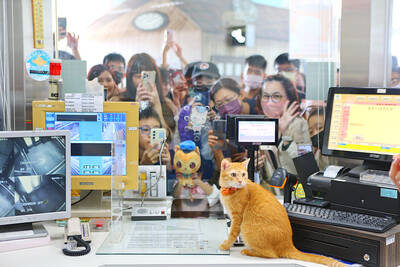Taiwan and Japan struck a compromise in talks in Taipei on Friday about allowing fishing boats from both sides to operate in overlapping waters in the East China Sea, Fishery Agency Director-General James Sha (沙志一) said.
Under the agreement, there will be no exclusion of fishing boats from either side in fishing grounds shared by fishing boats from the two countries.
Ground rules were also established to avoid friction caused by different operating methods, Sha said.
The rules were targeted at the 4,530km2 zone surrounding the Diaoyutai Islands (釣魚台) in the East China Sea that was opened to Taiwanese fishing vessels in a historic fishing agreement signed by Taiwan and Japan in April last year.
The two sides agreed that all fishing boats should adopt the Japanese method of operations in one area of the zone (known as Z1) east of the Diaoyutais from May to early July and in another area north of the Yaeyama Islands (known as Z2) from April to July, the traditional tuna-fishing season, Sha said.
At all other times of the year, fishing boats should adopt the Taiwanese approach, the official said.
The Japanese side will also notify Taiwan’s fishing association before its boats can operate in those two areas, Sha said.
The guidelines were needed to prevent conflicts as Japanese fishing boats draw their lines in a north-south direction and maintain a 4 nautical mile (7.4km) distance between them, while the Taiwanese boats deploy lines in an east-west direction and maintain a distance of 1 nautical mile.
Fishermen from the Yaeyama Islands had also complained about being forced out of the Z2 area by the large numbers of Taiwanese fishing boats converging there since the agreement was signed, Sha said.
Both sides also agreed to make sure all fishing boats are insured, he said.

WANG RELEASED: A police investigation showed that an organized crime group allegedly taught their clients how to pretend to be sick during medical exams Actor Darren Wang (王大陸) and 11 others were released on bail yesterday, after being questioned for allegedly dodging compulsory military service or forging documents to help others avoid serving. Wang, 33, was catapulted into stardom for his role in the coming-of-age film Our Times (我的少女時代). Lately, he has been focusing on developing his entertainment career in China. The New Taipei District Prosecutors’ Office last month began investigating an organized crime group that is allegedly helping men dodge compulsory military service using falsified documents. Police in New Taipei City Yonghe Precinct at the end of last month arrested the main suspect,

A cat named Mikan (蜜柑) has brought in revenue of more than NT$10 million (US$305,390) for the Kaohsiung MRT last year. Mikan, born on April 4, 2020, was a stray cat before being adopted by personnel of Kaohsiung MRT’s Ciaotou Sugar Refinery Station. Mikan was named after a Japanese term for mandarin orange due to his color and because he looks like an orange when curled up. He was named “station master” of Ciaotou Sugar Refinery Station in September 2020, and has since become famous. With Kaohsiung MRT’s branding, along with the release of a set of cultural and creative products, station master Mikan

Eleven people, including actor Darren Wang (王大陸), were taken into custody today for questioning regarding the evasion of compulsory military service and document forgery, the New Taipei District Prosecutors’ Office said. Eight of the people, including Wang, are suspected of evading military service, while three are suspected of forging medical documents to assist them, the report said. They are all being questioned by police and would later be transferred to the prosecutors’ office for further investigation. Three men surnamed Lee (李), Chang (張) and Lin (林) are suspected of improperly assisting conscripts in changing their military classification from “stand-by

LITTORAL REGIMENTS: The US Marine Corps is transitioning to an ‘island hopping’ strategy to counterattack Beijing’s area denial strategy The US Marine Corps (USMC) has introduced new anti-drone systems to bolster air defense in the Pacific island chain amid growing Chinese military influence in the region, The Telegraph reported on Sunday. The new Marine Air Defense Integrated System (MADIS) Mk 1 is being developed to counter “the growing menace of unmanned aerial systems,” it cited the Marine Corps as saying. China has constructed a powerful defense mechanism in the Pacific Ocean west of the first island chain by deploying weapons such as rockets, submarines and anti-ship missiles — which is part of its anti-access/area denial (A2/AD) strategy against adversaries — the